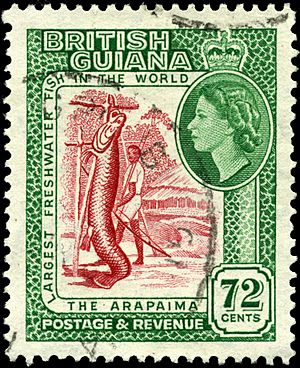Pirarucu facts for kids
Quick facts for kids Pirarucu |
|
|---|---|
 |
|
| Conservation status | |
| Scientific classification | |
| Genus: |
Arapaima
|
| Species: |
gigas
|
| Synonyms | |
|
|
The Arapaima, also known as pirarucu, is a giant freshwater fish. It lives in the Amazon River basin in South America. This amazing fish is one of the largest freshwater fish on Earth! It needs to come to the surface often to breathe air, just like you do.
Contents
What Does the Arapaima Look Like?
The arapaima is one of the biggest freshwater fish known. It usually grows to about 200 centimeters (about 6.5 feet) long. Some have even been reported to reach an incredible 450 centimeters (almost 15 feet)! Adults can weigh up to 200 kilograms (about 440 pounds).
This fish has a sleek body. Its fins are set far back near its tail. The arapaima is mostly gray to gray-green. However, its Brazilian name pirarucu means "red fish." This name might come from the red spots on its scales near its tail. It could also refer to the reddish-orange color of its meat.
The arapaima has special scales that are like armor. They have a hard outer layer made of minerals. Underneath, there's a tough but flexible inner layer. This armor helps protect the fish from attacks by dangerous piranhas.
Where Do Arapaima Live?
Arapaima live in the freshwater of the Amazon River basin. You can find them in countries like Bolivia, Brazil, Guyana, and Peru.
In Bolivia, this fish is called paiche. It is seen as an invasive species there. This means it's a species that was brought to a new place and is now causing problems for the local plants and animals. The arapaima was first found in Bolivia in 1976. It likely escaped from a fish farm in Peru during a flood.
Arapaima have also been introduced to parts of East Asia. They were brought there for fishing or sometimes by accident. These fish like to live in flooded forest areas. They lay their eggs there during the wet season. When the water levels drop, they move to lakes.
Scientists have even found a fossil of an arapaima in Colombia! This fossil is about 13 million years old. It shows that fish very similar to the arapaima have been around for a very long time.
How Do Arapaima Breathe?
Arapaima are special because they need to breathe air from the surface. They can't get enough oxygen just from the water using their gills. They come up every 5 to 15 minutes to gulp air loudly. They use a special organ that is like a lung, which is actually a changed swim bladder.
Arapaima Life Cycle and Diet
Arapaima mostly eat other fish. However, young arapaima prefer to eat insects and tiny fish when they are small. As they grow bigger, they also eat birds, small mammals, fruits, and seeds that fall onto the water's surface.
Arapaima lay their eggs in lakes and river channels. This happens when water levels are low, usually from August to March. Both parent fish build a nest for the eggs. After the eggs hatch, the male fish stays to protect the young for about three months. Young arapaima become adults and can have their own babies when they are four or five years old. In places like aquariums, they can live for 15 to 20 years.
Protecting the Arapaima
In the past, too many arapaima were caught by fishing. It was easy to catch them because they have to come to the surface to breathe. This caused their numbers to drop a lot.
The IUCN (International Union for Conservation of Nature) is an organization that checks on animal populations. They currently don't have enough information to say exactly how many arapaima are left.
Brazil completely banned arapaima fishing from 1996 to 1999. This was because their populations were getting too small. Since then, people are allowed to fish for them in special areas. Brazil has a smart plan to manage fishing sustainably. This means they make sure enough fish are left to have babies. Thanks to this plan, the number of arapaima has grown a lot! In 1999, there were only about 2,500 arapaima. By 2017, there were over 170,000!
In Bolivia, the paiche (arapaima) is seen as a threat to local fish species. Some reports show that as the paiche spread, the number of native fish in parts of the Bolivian Amazon went down. However, the effects on local fish and fishing can be different in various regions. A study from 2017 by the Bolivian government and researchers said that more research is needed to understand the full impact of the paiche in the country.
Images for kids
See also
 In Spanish: Arapaima para niños
In Spanish: Arapaima para niños




